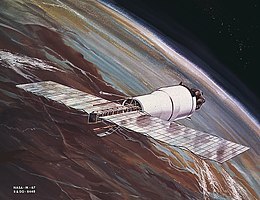This article needs additional citations for verification. (December 2013) |
 Pegasus micrometeoroid detection satellite as flown aboard AS-103 | |
| Mission type | Spacecraft aerodynamics; Micrometeoroid investigation |
|---|---|
| Operator | NASA |
| COSPAR ID | 1965-009B |
| SATCAT no. | 1088 |
| Mission duration | 3 years, 6 months, 13 days |
| Distance travelled | 3,114,579,139 kilometers (1.935309753×109 mi) |
| Orbits completed | ~75,918 |
| Spacecraft properties | |
| Spacecraft | Apollo BP-16 Pegasus 1 |
| Launch mass | 15,375 kilograms (33,896 lb) |
| Start of mission | |
| Launch date | February 16, 1965, 14:37:03 UTC |
| Rocket | Saturn I SA-9 |
| Launch site | Cape Kennedy LC-37B |
| End of mission | |
| Disposal | Decommissioned |
| Deactivated | August 29, 1968 |
| Decay date | July 10, 1985 |
| Orbital parameters | |
| Reference system | Geocentric |
| Regime | Low Earth orbit |
| Perigee altitude | 500 kilometers (310 mi) |
| Apogee altitude | 736 kilometers (457 mi) |
| Inclination | 31.7 degrees |
| Period | 97.06 minutes |
| Epoch | 22 March 1965[1] |
AS-103 was the third orbital flight test of a boilerplate Apollo spacecraft, and the first flight of a Pegasus micrometeoroid detection satellite. Also known as SA-9, it was the third operational launch of a two-stage Saturn I launch vehicle.
- ^ McDowell, Jonathan. "Satellite Catalog". Jonathan's Space Page. Retrieved October 31, 2013.